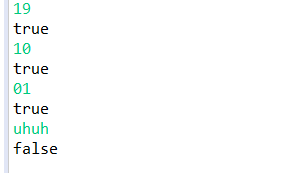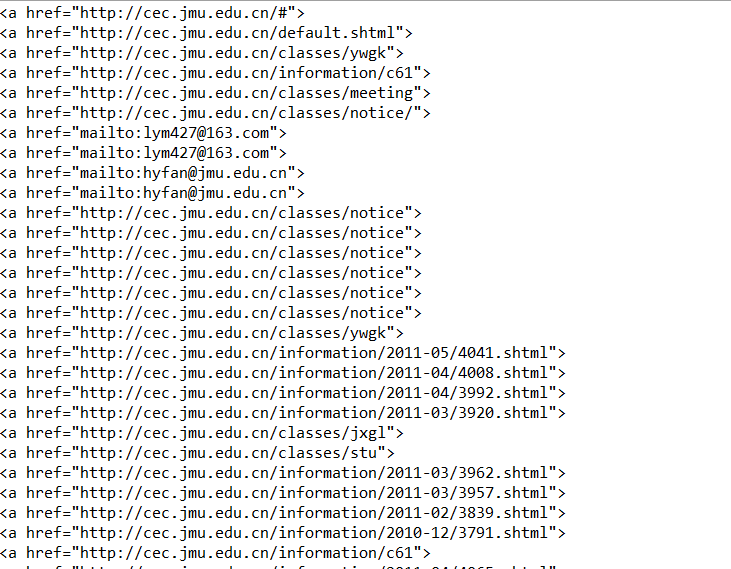0. 字节流与二进制文件
我的代码
package experiment0;
import java.io.DataInputStream;
import java.io.DataOutputStream;
import java.io.FileInputStream;
import java.io.FileNotFoundException;
import java.io.FileOutputStream;
import java.io.IOException;
public class Main {
public static void main(String[] args)
{
String fileName="d:\student.data";//文件地址
try(DataOutputStream dos=new DataOutputStream(new FileOutputStream(fileName)))//写入二进制文件
{
Student student1=new Student(1,"xixi",19,89);
dos.writeInt(student1.getId());
dos.writeUTF(student1.getName());
dos.writeInt(student1.getAge());
dos.writeDouble(student1.getGrade());
} catch (FileNotFoundException e) {
e.printStackTrace();
} catch (IOException e) {
e.printStackTrace();
}
System.out.println("ojk");
try(DataInputStream dis=new DataInputStream(new FileInputStream(fileName)))//读取文件并输出
{
int id=dis.readInt(),age=dis.readInt();
String name=dis.readUTF();
double grade=dis.readDouble();
Student student2=new Student(id,name,age,grade);//存入对象
System.out.println(student2.toString());//输出
} catch (FileNotFoundException e) {
e.printStackTrace();
} catch (IOException e) {
e.printStackTrace();
}
}
}
二进制与文本,前者是数据的原形式后者是数据的终端形式。
在使用try...catch...finally时要避免在finally中使用return 语句或者抛出异常.
1. 字符流与文本文件:使用 PrintWriter(写),BufferedReader(读)
1.1使用BufferedReader从编码为UTF-8的文本文件中读出学生信息,并组装成对象然后输出。
package expriment1_1;
import java.io.BufferedReader;
import java.io.FileInputStream;
import java.io.FileNotFoundException;
import java.io.IOException;
import java.io.InputStreamReader;
import java.util.ArrayList;
import java.util.List;
public class main {
public static void main(String[] args) {
String fileName="d:\Students.txt";//文件地址
List<Student> studentList = new ArrayList<>();//以Student对象 的list
try(
FileInputStream fis=new FileInputStream(fileName);
InputStreamReader isr=new InputStreamReader(fis, "UTF-8");//转换流
BufferedReader br=new BufferedReader(isr))
{
String line=null;
while((line=br.readLine())!=null)
{
String[] msg=line.split("\s+");
int id=Integer.parseInt(msg[0]);
String name=msg[1];
int age=Integer.parseInt(msg[2]);
double grade=Double.parseDouble(msg[3]);
Student stu=new Student(id,name,age,grade);
studentList.add(stu);
}
}
catch (FileNotFoundException e)
{
e.printStackTrace();
}
catch (IOException e)
{
e.printStackTrace();
}
System.out.println(studentList);
}
}
1.2编写public static ListreadStudents(String fileName);从fileName指定的文本文件中读取所有学生,并将其放入到一个List中
public static List<Student> readStudents(String fileName)
{
List<Student> studentList = new ArrayList<>();
try(
FileInputStream fis=new FileInputStream(fileName);
InputStreamReader isr=new InputStreamReader(fis, "UTF-8");
BufferedReader br=new BufferedReader(isr))
{
String line=null;
while((line=br.readLine())!=null)
{
String[] msg=line.split("\s+");
int id=Integer.parseInt(msg[0]);
String name=msg[1];
int age=Integer.parseInt(msg[2]);
double grade=Double.parseDouble(msg[3]);
Student stu=new Student(id,name,age,grade);
studentList.add(stu);
}
}
catch (FileNotFoundException e)
{
// TODO Auto-generated catch block
e.printStackTrace();
}
catch (IOException e)
{
// TODO Auto-generated catch block
e.printStackTrace();
}
return studentList;
}
1.3使用PrintWriter将Student对象写入文本文件,基础代码见后。注意:缓冲区问题。
package experime1_3;
import java.io.FileNotFoundException;
import java.io.FileOutputStream;
import java.io.IOException;
import java.io.OutputStreamWriter;
import java.io.PrintWriter;
public class main {
public static void main(String[] args) {
String fileName="d:\Students.txt";
try(
FileOutputStream fos=new FileOutputStream(fileName,true);
OutputStreamWriter osw=new OutputStreamWriter(fos,"UTF-8");
PrintWriter pw=new PrintWriter(osw))
{
pw.println();
pw.print("4 小羊 12 88");
} catch (FileNotFoundException e) {
// TODO Auto-generated catch block
e.printStackTrace();
} catch (IOException e) {
// TODO Auto-generated catch block
e.printStackTrace();
}
}
}

1.4使用ObjectInputStream/ObjectOutputStream读写学生对象
package experiment1_4;
import java.io.FileInputStream;
import java.io.FileOutputStream;
import java.io.IOException;
import java.io.ObjectInputStream;
import java.io.ObjectOutputStream;
import experiment0.Student;
public class main {
public static void main(String[] args) {
String fileName1="d:\Students.dat";
try(
FileOutputStream fos=new FileOutputStream(fileName1);
ObjectOutputStream oos=new ObjectOutputStream(fos))
{
Student ts=new Student(5,"asd",14,60);
oos.writeObject(ts);
}
catch (Exception e) {
// TODO Auto-generated catch block
e.printStackTrace();
}
try(
FileInputStream fis=new FileInputStream(fileName1);
ObjectInputStream ois=new ObjectInputStream(fis))
{
Student newStudent =(Student)ois.readObject();
System.out.println(newStudent);
} catch (IOException e) {
// TODO Auto-generated catch block
e.printStackTrace();
} catch (ClassNotFoundException e) {
// TODO Auto-generated catch block
e.printStackTrace();
}
}
}

使用程序生成的文件是支持UTF-8
方法writeObject处理对象的序列化
2缓冲流(结合使用JUint进行测试)
对文件进行1000万次写入
String FILENAME = "D:\test.txt";
double sum=0,aver;
PrintWriter pw=null;
try {
pw = new PrintWriter(FILENAME);
for(int i = 0;i<1000_0000;i++){//写入1千万行
int x=new Random().nextInt(10);
sum+=x;
pw.println(x);
//System.out.println(x);
}
} catch (FileNotFoundException e) {
e.printStackTrace();
}finally{
pw.close();
}
aver=sum/10000000;
System.out.format("%.6f", aver);
JUnit
public class test {
@Test
public void test() {
String FILENAME = "test.txt";
long begin = System.currentTimeMillis();
Scanner scanner=null;
try {
scanner = new Scanner(new File(FILENAME));
while(scanner.hasNextLine()){//只是读出每一行,不做任何处理
scanner.nextLine();
}
} catch (FileNotFoundException e) {
e.printStackTrace();
}finally{
scanner.close();
}
System.out.println("1 ok");
}
@Test
public void Bufftest() {
String FILENAME = "test.txt";
long begin = System.currentTimeMillis();
BufferedReader br = null;
try {
br = new BufferedReader(new FileReader(new File(FILENAME)));
while(br.readLine()!=null){};//只是读出,不进行任何处理
} catch (FileNotFoundException e) {
e.printStackTrace();
} catch (IOException e) {
e.printStackTrace();
}finally{
try {
br.close();
} catch (IOException e) {
e.printStackTrace();
}
}
System.out.println("2 ok");
}
}
在进行JUnit测试是要注意测试方法必须使用public void进行修饰,不能带任何的参数
并且要新建一个源代码目录来存放我们的测试代码
3. 字节流之对象流
public static void writeStudent(List<Student> stuList)
{
String fileName="d:\Students.dat";
try ( FileOutputStream fos=new FileOutputStream(fileName);
ObjectOutputStream ois=new ObjectOutputStream(fos))
{
ois.writeObject(stuList);
}
catch (FileNotFoundException e) {
e.printStackTrace();
} catch (IOException e1) {
e1.printStackTrace();
}
}
public static List<Student> readStudents(String fileName)
{
List<Student> stuList=new ArrayList<>();
try ( FileInputStream fis=new FileInputStream(fileName);
ObjectInputStream ois=new ObjectInputStream(fis))
{
stuList=(List<Student>)ois.readObject();
}
catch (FileNotFoundException e) {
e.printStackTrace();
} catch (IOException e1) {
e1.printStackTrace();
} catch (ClassNotFoundException e) {
e.printStackTrace();
}
return stuList;
}
当使用对象流写入或者读取对象的时候,必须保证该对象是序列化的,这样是为了保证对象能够正确的写入文件,并能够把对象正确的读回程序。
5. 文件操作
public static void findFile(Path dir,String fileName) {
File file = dir.toFile();
File[] files=file.listFiles();
for(File f:files)
{
if(f.isFile())
{
if(f.getName().equals(fileName))
{
System.out.println(f.getAbsolutePath());
return;
}
}
else if(f.isDirectory())
{
findFile(f.toPath(),fileName);
}
}
}
在查阅资料File类和Path类之间是可以互相转换
6. 正则表达式
6.1如何判断一个给定的字符串是否是10进制数字格式?尝试编程进行验证。
public class Main {
public static void main(String[] args) {
Scanner sc=new Scanner(System.in);
Pattern pattern=Pattern.compile("^[+-]?[0-9]+(\.\d+)?");
Matcher matcher=null;
while(sc.hasNext())
{
String str=sc.next();
matcher=pattern.matcher(str);
System.out.println(matcher.matches());
}
sc.close();
}
}

6.2修改HrefMatch.java
package experiment6_2;
import java.io.*;
import java.net.*;
import java.util.regex.*;
/**
* This program displays all URLs in a web page by matching a regular expression that describes the
* <a href=...> HTML tag. Start the program as <br>
* java HrefMatch URL
* @version 1.01 2004-06-04
* @author Cay Horstmann
*/
public class HrefMatch
{
public static void main(String[] args)
{
try
{
// get URL string from command line or use default
/* String urlString;
if (args.length > 0) urlString = args[0];
else urlString = "http://cec.jmu.edu.cn";*/
String fileName="F:\计算机语言的学习文件\JAVA 学习资料\下载文件\Exp-StreamAndFile\Exp-StreamAndFile\参考代码\HrefMatch\集美大学-计算机工程学院.htm";
// open reader for URL
//InputStreamReader in = new InputStreamReader(new URL(urlString).openStream());
InputStreamReader in = new InputStreamReader(new FileInputStream(fileName));
//InputStreamReader in = new InputStreamReader(new FileInputStream("集美大学-计算机工程学院.htm"));
// read contents into string builder
StringBuilder input = new StringBuilder();
int ch;
while ((ch = in.read()) != -1)
input.append((char) ch);
// search for all occurrences of pattern
String patternString = "<a\s+href\s*=\s*("[^"]*"|[^\s>]*)\s*>";
String patternImgString = "[+-]?[0-9]+";
//String patternString = "[u4e00-u9fa5]"; //匹配文档中的所有中文
Pattern pattern = Pattern.compile(patternString, Pattern.CASE_INSENSITIVE);
Matcher matcher = pattern.matcher(input);
while (matcher.find())
{
int start = matcher.start();
int end = matcher.end();
String match = input.substring(start, end);
System.out.println(match);
}
}
catch (IOException e)
{
e.printStackTrace();
}
catch (PatternSyntaxException e)
{
e.printStackTrace();
}
}
}

总的来说这些都是课上有完成的内容,但是量比较多,回来后也有些遗忘,在写这些的时候花费了很多时间才完成!